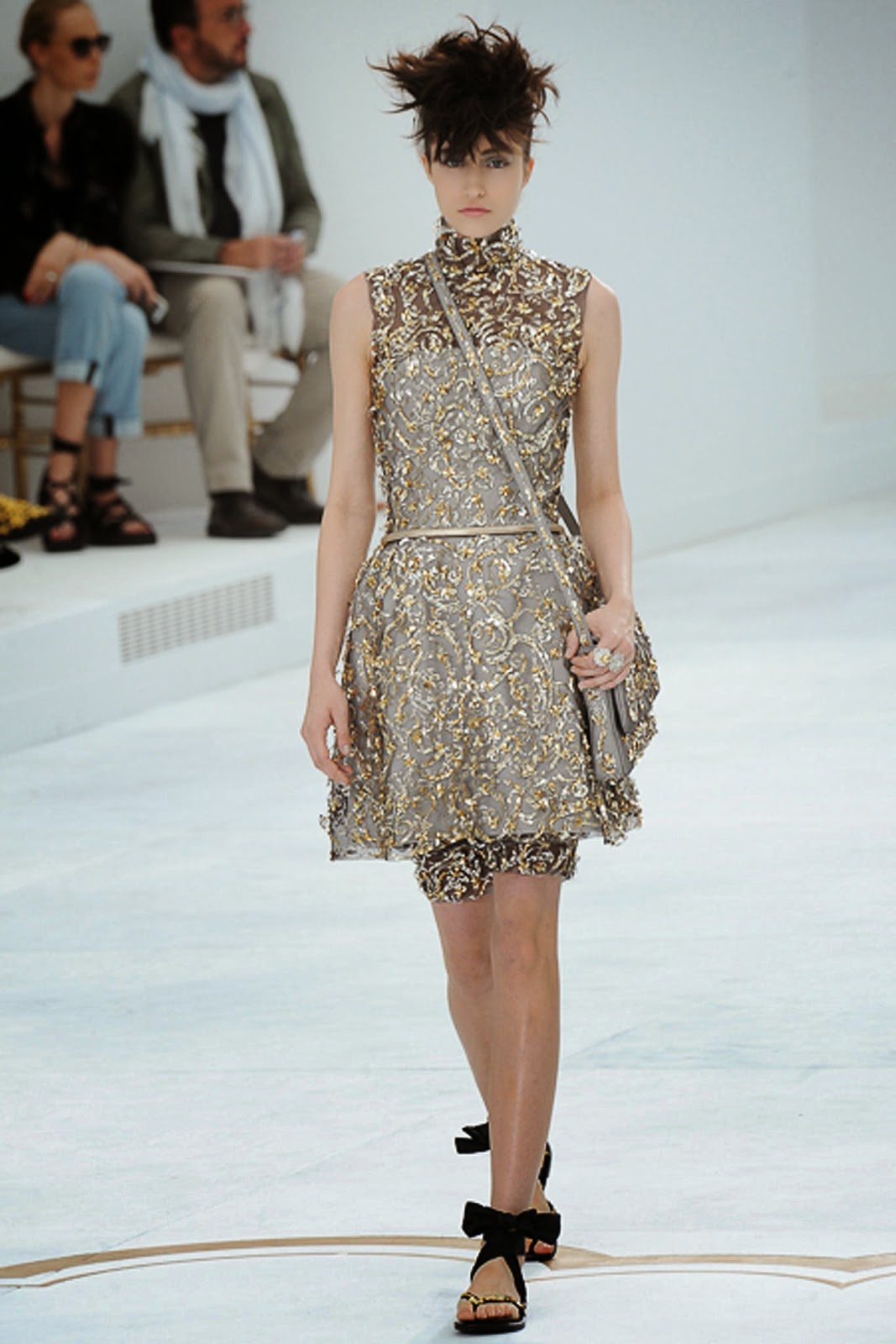After the breathtakingly spectacular environments that Karl Lagerfeld has conceived for CHANEL Couture in recent years who could forget the Chateau de Versailles, the enchanted Mediterranean forest, the derelict antebellum theater (not to mention the CHANEL supermarket for this fall’s ready to wear!) this season’s set was a palate cleanser. And rightly so: All the focus was on the superb clothes, each one a miracle of construction, workmanship, and sophisticated embellishment.
“Le Corbusier goes to Versailles!” Karl pronounced. “Modernity with baroque elements!”
Karl’s reference was revealed when the sliding doors at either end of his wide runway opened to reveal mirror-image riffs on the époque-defining penthouse apartment that Le Corbusier created in the mid-thirties for the wealthy aesthete Carlos de Beistegui. At the time, Beistegui promptly layered the architect’s modernist vision with modishly surrealist and flamboyant decorative touches. “He mixed very modern things with eighteenth-century,” noted Karl during fittings on the Rue Cambon. (Karl himself, of course, has been known to mix just those elements both in his home environments and on his runways.)
So those sliding doors opened to reveal a matched set or rococo fireplaces (with virtual video flames dancing away) set into an evocation of Corbusier’s low white wall—the original provided a glimpse of the Arc de Triomphe. The Chanel girls appeared from both sides, and it was difficult to keep up with them—and the ideas embodied in Karl’s exciting clothes.
In fashion terms, the clash of aesthetics meant shapes of architectural purity such as stiffly tailored jackets that had the flare of an eighteenth-century courtier’s frockcoat and were worn with tight knickerbockers (Karl calls them cyclist’s shorts). The satchel bags, kepi hats (worn back to front to bare hairdresser Sam McKnight’s messy rockabilly quiffs), and the deluxe flip-flops with jewel straps and taffeta ribbon ties added a relaxed and thoroughly contemporary edge.
Those suits segued into a bevy of miraculously seamless dresses, their belling or gently A-line skirts molded from neoprene crepe that were lavishly embellished with Sun King sequins, beads, and even tiny little chunks of Corbusier’s beloved cement (a Chanel innovation that took three years to develop). Meanwhile, the eighteenth-century paste brooches were blown up huge and replicated in embroidery motifs, sequins were sewn on their edges onto the fabric for a bristling effect, and those cinematic flames were reimagined in tweeds that wove ribbon, woolen strands, plastic filament, and even feathers into intriguingly textured fabrics (resembling at times the richly detailed textile works of artist Sheila Hicks), the color of smoldering embers or bright orange flames.
In homage perhaps to Corbusier’s roofless living room terrace there was a dress that looked like a Magritte cloudscape with powder blue feathers tumbled into puffs of pale tulle, and another that looked like a lightning streak of silvery sequins.
Karl’s pregnant bride, meanwhile, had the look of a medieval queen, the van Eyck silhouette flourished with a train of sublimely elaborate embroidery. When the girls appeared for the finale, like twin armies meeting and blending together, it was a powerful fashion moment.
As the hordes rushed back to congratulate Karl he was as sanguine as ever. “Like I say,” he pronounced of this astonishing collection, “it doesn’t make the next one.”
Selections by ANDREA JANKE Finest Accessories
Photo Credit/Source: VOGUE & The House of CHANEL
Photos by Benoit Peverelly (CHANEL);
Kevin Tachman, Kim Weston Arnold and Yannis Vlamos (Indigitalimages)
'Paris Haute Couture | VALENTINO Fall 2014 Couture'
Kevin Tachman, Kim Weston Arnold and Yannis Vlamos (Indigitalimages)
More To Love ...
'Paris Haute Couture | VALENTINO Fall 2014 Couture'
Every one of the looks Maria Grazia Chiuri and Pierpaolo Piccioli sent out were inspired by the works of Pre-Raphaelite painters and poets, but first among them was a white draped tunic dress named after Alma-Tadema’s sultry study of a sleeping nymph, The Siesta, of 1868.
VALENTINO Haute Couture backstage, close up of the finale look:
40 meters of lamé amd 2.000 hours of application work. The design depicts
an imaginary merry-go-round!

















































































No comments:
Post a Comment